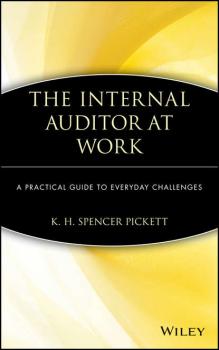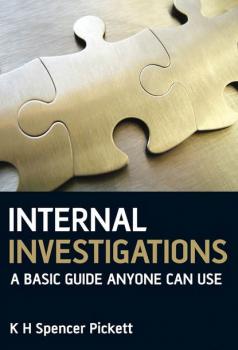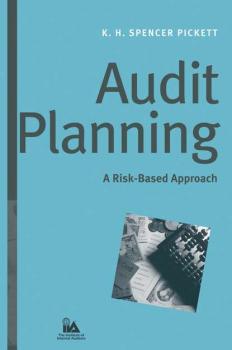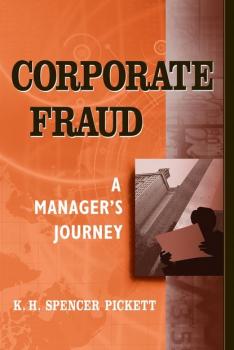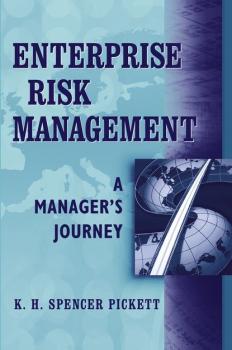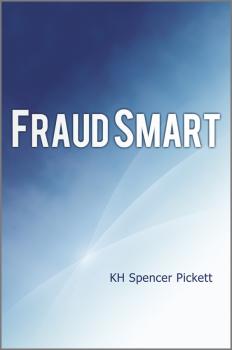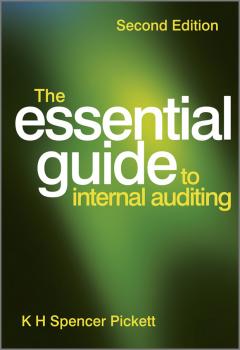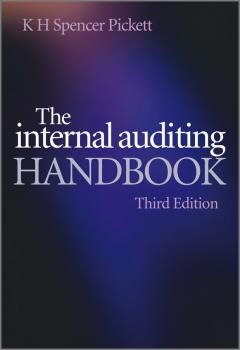ТОП просматриваемых книг сайта:
K. H. Spencer Pickett
Список книг автора K. H. Spencer PickettАннотация
A clear, accessible guide to the roles and responsibilities of today's internal auditor At a time when companies are seeking to reevaluate their practices and add value to their audit processes, The Internal Auditor at Work represents an invaluable, user-friendly, and up-to-date guidebook for the internal auditing professional to refine and rethink both day-to-day methods and the underlying significance of the job. Each chapter of this in-depth, functional analysis contains numerous resources to guide the reader toward greater understanding and performance. Discussion questions promote dialogue among auditing professionals on the various topics covered. Top ten considerations lists recap the important points of each chapter. And end-of-chapter exercises are especially valuable to new internal auditors in that they facilitate self-development and application of principles covered. Written in partnership with the Institute of Internal Auditors with special attention to its revised standards and guidelines, The Internal Auditor at Work includes chapters on: The audit context The strategic dimension Quality and audit competence The audit process The audit proposition And more In a business environment currently undergoing major reevaluation, The Internal Auditor at Work provides an invaluable tool for internal auditing professionals and all others with an interest in adding value to their organizational processes.
Аннотация
The book provides a simple but effective method for carrying out reliable and defensible internal investigations. This easy-to-use guide offers anyone asked to conduct such an investigation a working set of standards, set out in a BASIC approach that follows five main steps: Beginning the Investigation, Assessing the Issues, Substantiating the Claims, Investigating the Implications, and Communicating the results. Using the BASIC approach, all senior employees and associates will be able to to develop an important new skills-set that will help them conduct a credible internal investigation, as and when required.
Аннотация
More now than ever before, auditing is in the spotlight; legislators, regulators, and top executives in all types of businesses realize the importance of auditors in the governance and performance equation. Previously routine and formulaic, internal auditing is now high-profile and high-pressure! Being an auditor in today's complex, highly regulated business environment involves more than crunching the numbers and balancing the books-it requires ensuring that appropriate checks and balances are in place to manage risk throughout the organization. Designed to help auditors in any type of business develop the essential understanding, capabilities, and tools needed to prepare credible, defensible audit plans, Audit Planning: A Risk-Based Approach helps auditors plan the audit process so that it makes a dynamic contribution to better governance, robust risk management, and more reliable controls. Invaluable to internal auditors facing new demands in the workplace, this book is also a «hands-on» reference for external auditors, compliance teams, financial controllers, consultants, executives, small business owners, and others charged with reviewing and validating corporate governance, risk management, and controls. The second book in the new Practical Auditor Series, which helps auditors get down to business, Audit Planning: A Risk-Based Approach gives new auditors principles and methodologies they can apply effectively and helps experienced auditors enhance their skills for success in the rapidly changing business world.
Аннотация
An entertaining introduction to a serious issue It's not a secret that corporate fraud and scandal are real threats to business today, from which no organization is immune. Fraud losses are devastating-but they are also highly avoidable. The third book in the A Manager's Journey series, Corporate Fraud follows Bill Reynolds first to New York City and then to Florida where, along with his colleague Jack, he sets up an anti-fraud policy within their company and investigates allegations made by a whistleblower in their Orlando office-until the whistleblower disappears. Unconventional in approach, yet extraordinarily useful, Corporate Fraud is sprinkled with practical examples and workable solutions that take you from zero understanding of organizational fraud to integration of corporate fraud risk management and sound internal controls into everyday work. Through Bill's latest journey, you'll discover how to manage the risk of fraud across all parts of your business and meet the requirements of Sarbanes-Oxley as well as public sector regulations. It's the definitive resource for managers, auditors, fraud examiners, CFOs, and workteams, with relevant information on preventing and detecting fraud within your organization.
Аннотация
A bona fide «novel» approach to successful ERM implementation With the release of the new COSO ERM guidelines, many managers are being asked to implement Enterprise Risk Management (ERM) with very little understanding of the full implications for their business and customers. In Enterprise Risk Management, you'll learn the A-to-Zs of ERM by walking in the shoes of Bill Reynolds as he goes from zero understanding of ERM to becoming fully versed in what ERM is, what it can do for his company, and how to successfully implement it within his organization. Through Bill's enlightening business trip to London, you will discover how to manage risk across all parts of your business.
Аннотация
Risk management is a part of mainstream corporate life that touches all aspects of every type of organization. Auditors must focus firmly on risk: risk to the business, the executives, and the stakeholders. Auditing the Risk Management Process incorporates all the latest developments in risk management as it applies to auditors, including the new Committee of Sponsoring Organizations of the Treadway Commission (COSO) enterprise risk paper. Auditing the Risk Management Process includes original risk maps and process models developed by the author, explaining where and how topics fit within an overall audit framework, all the latest developments in risk management as it applies to auditors, and insight into how enterprise risk management affects the responsibilities of both internal and external auditors.
Аннотация
A professional guide to developing training for fraud risk and detection This book provides a simple but effective method of developing a fraud risk awareness strategy that focuses on training employees using a six-stage approach to this task that involves understanding the threat, appreciating respective responsibilities, embracing a sound moral compass, recognizing red flags, mastering suitable internal controls, and managing the risk of fraud. Using this step-by-step approach, all senior executives, managers, employees, and associates can develop an important new skill set that will help them understand and deal with the risk of fraud in the workplace.
Аннотация
The Second Edition of The Essential Guide to Internal Auditing is a condensed version of the Handbook of Internal Auditing, Third Edition. It shows internal auditors and students in the field how to understand the audit context and how this context fits into the wider corporate agenda. The new context is set firmly within the corporate governance, risk management, and internal control arena. The new edition includes expanded coverage on risk management and is updated throughout to reflect the new IIA standards and current practice advisories. It also includes many helpful models, practical guidance and checklists.
Аннотация
The first edition of The Internal Auditing Handbook received wide acclaim from readers and became established as one of the definitive publications on internal auditing. The second edition was released soon after to reflect the rapid progress of the internal audit profession. There have been a number of significant changes in the practice of internal auditing since publication of the second edition and this revised third edition reflects those changes. The third edition of The Internal Auditing Handbook retains all the detailed material that formed the basis of the second edition and has been updated to reflect the Institute of Internal Auditor’s (IIA) International Standards for the Professional Practice of Internal Auditing. Each chapter has a section on new developments to reflect changes that have occurred over the last few years. The key role of auditors in reviewing corporate governance and risk management is discussed in conjunction with the elevation of the status of the chief audit executive and heightened expectations from boards and audit committees. Another new feature is a series of multi-choice questions that have been developed and included at the end of each chapter. This edition of The Internal Auditing Handbook will prove to be an indispensable reference for both new and experienced auditors, as well as business managers, members of audit committees, control and compliance teams, and all those who may have an interest in promoting corporate governance.

